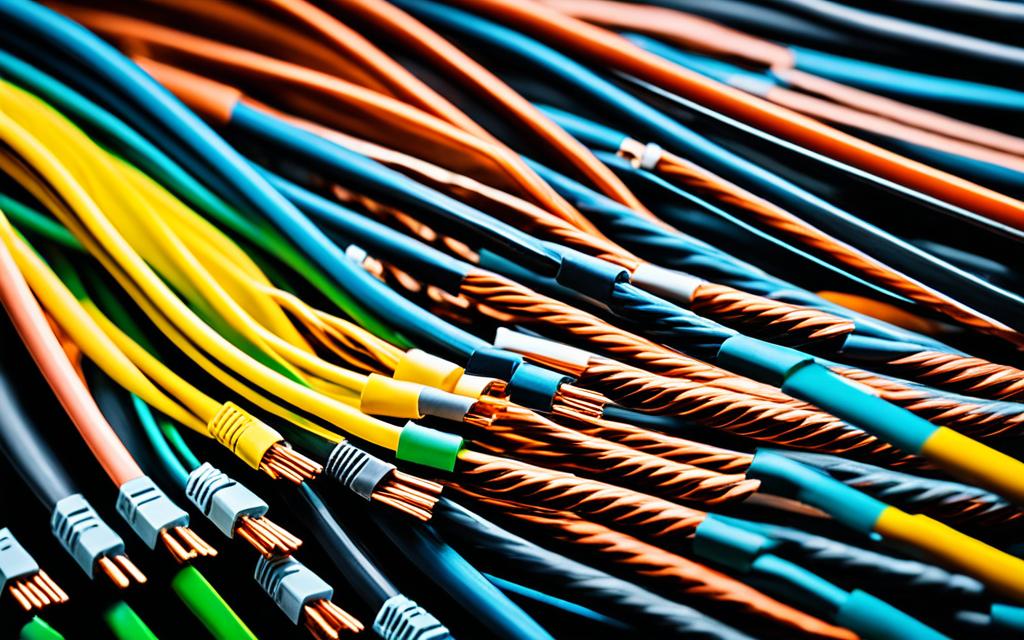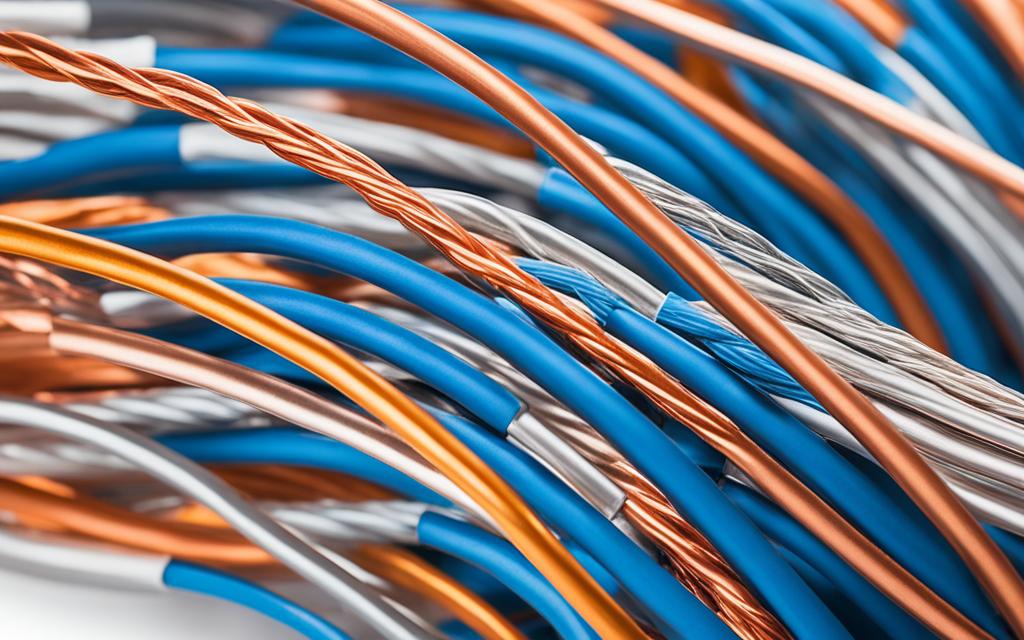Twisted-pair cabling is an essential component of networking and communication systems. It consists of one or more pairs of copper wires twisted together and insulated with a dielectric compound. The twisting helps minimize electromagnetic radiation, resist external interference, and limit interference with adjacent cables.
Twisted-pair cables are widely used in various applications, such as telephone lines, Digital Subscriber Line (DSL), and local area networks (LANs). They come in two types: Unshielded Twisted Pair (UTP) and Shielded Twisted Pair (STP). UTP cables are the most common and cost-effective choice, while STP cables provide better protection against noise and signal interference.
Twisted-pair cables are categorized based on their rated speeds, with higher-class cables offering higher transmission rates.
In this article, we will explore the different categories of twisted-pair cabling systems, their applications, and the importance of copper in data transmission. Let’s dive in!
Categories of Twisted-Pair Cabling Systems
In the world of networking and communication, twisted-pair cables play a crucial role. These cables consist of one or more pairs of copper wires that are twisted together and insulated to ensure reliable data transmission. Twisted-pair cables are widely used in various applications, including telephone lines, Digital Subscriber Line (DSL), and local area networks (LANs).
When it comes to twisted-pair cabling, there are two main categories to consider: Unshielded Twisted Pair (UTP) and Shielded Twisted Pair (STP). Let’s take a closer look at each type:
Unshielded Twisted Pair (UTP) Cables
UTP cables are the most common and cost-effective choice for networking and telephone systems. These cables have no internal shielding and are known for their low cost, ease of installation, and flexibility. UTP cables are primarily used in Ethernet networks and traditional telephone systems.
UTP cables are popular due to their affordability, ease of installation, and flexibility. However, they are vulnerable to signal interference and have limitations when it comes to long-distance transmissions.
Shielded Twisted Pair (STP) Cables
STP cables, on the other hand, offer enhanced protection against noise and signal interference. They include a shielding made of aluminum foil or braided wire, which helps to minimize electromagnetic radiation and external interference. STP cables are more expensive and harder to connect compared to UTP cables, but the additional cost is justified in applications where signal quality is crucial.
STP cables provide better protection against noise and signal interference, making them a preferred choice in environments where maintaining high signal quality is essential.
Both UTP and STP cables are categorized based on their rated speeds, with different classes indicating varying transmission rates. Let’s take a closer look at the different categories of twisted-pair cables:
| Category | Maximum Data Rate | Transmission Distance |
|---|---|---|
| Cat1 | Not suitable for networking applications | Not suitable for networking applications |
| Cat2 | 4Mbps | Not commonly used today |
| Cat3 | 10Mbps | Limited data transmission rates |
| Cat4 | 16Mbps | Similar to Cat3; not commonly used today |
| Cat5 | 100Mbps | Suitable for 100Base-T Ethernet networks |
| Cat5e | 1Gbps | Enhanced version of Cat5 for higher speeds |
| Cat6 | 10Gbps | Higher data transfer rates for shorter distances |
| Cat6a | 10Gbps | Same data transfer rates as Cat6, but for the full 100-meter distance |
| Cat7 | 10Gbps | Supports higher speeds, but not widely supported |
| Cat8 | 40Gbps | Suitable for high-speed networks |
Twisted-Pair Cable Categories and Their Applications
Twisted-pair cables play a crucial role in modern networking and communication systems. To ensure optimal performance, these cables are categorized into different classes based on their rated speeds and transmission distances. These categories are defined by international standards such as ISO/IEC 11801 and ANSI/EIA. Let’s explore these twisted-pair cable categories and their respective applications:
Cat1: Analog Voice Communications
Category 1 cables are primarily used for analog voice communications. These cables are not suitable for networking applications and have limited data transmission capabilities.
Cat2: Older IBM Token Ring Networks
Cat2 cables were commonly used in older IBM token ring networks. However, these cables are not commonly used today due to advancements in networking technology.
Cat3: 10Base-T Ethernet Networks and Digital Communications
Cat3 cables were the first to support 10Base-T Ethernet networks and digital communications. While they provided a significant improvement over Cat2 cables, their data transmission rates are limited.
Cat4: Older IBM Token Ring Networks
Cat4 cables were similar to Cat3 cables and were primarily used in older IBM token ring networks.
Cat5: 100Base-T Ethernet Networks
Introduced in 1995, Cat5 cables became the standard for 100Base-T Ethernet networks. They support data transmission rates of up to 100Mbps and are widely used in various applications.
Cat5e: Enhanced Performance
Cat5e cables are an enhanced version of Cat5 cables. They offer improved performance and support speeds of up to 1Gbps, making them suitable for high-speed networking applications.
Cat6: Higher Data Transfer Rates
Cat6 cables provide even higher data transfer rates compared to Cat5e cables. They support speeds of up to 10Gbps, making them ideal for short-distanced applications requiring high-bandwidth requirements.
Cat6a: Extended Distance Support
Cat6a cables offer the same data transfer rates as Cat6 cables but with extended distance support. They can maintain 10Gbps speeds over the full 100-meter distance, making them suitable for large-scale networks.
Cat7: High-Speed Networks
Cat7 cables support 10Gbps speeds and can theoretically support even higher speeds. However, they are not widely supported by networking equipment and are less commonly used in most applications.
Cat8: Maximum Data Rate
Cat8 cables offer the highest data rate among twisted-pair cable categories, with a maximum data rate of 40Gbps. These cables operate at a 2GHz bandwidth, making them suitable for high-speed networking applications that require exceptional performance.
In summary, twisted-pair cables are categorized into various classes based on their performance levels. Each category plays a unique role in supporting different data rates and transmission distances. Understanding these categories helps network administrators choose the appropriate cables for their specific applications, ensuring optimal network performance and reliability.

Twisted Pair Cable Design and Shielding
Twisted pair cables are crucial for ensuring optimal performance in networking and communication systems. These cables are designed with specific features that reduce electromagnetic interference and crosstalk between neighboring pairs, resulting in reliable data transmission. One key design element is the twisting of the wire pairs, which helps minimize noise signals and ensures equal distance from interfering sources for each wire.
Twisted pair cables can be categorized as Unshielded Twisted Pair (UTP) or Shielded Twisted Pair (STP). UTP cables, although cost-effective and flexible, do not come with internal shielding. They are commonly used in various networking applications, such as Ethernet networks and traditional telephone systems. On the other hand, STP cables include shielding, such as aluminum foil or braided wire, which provides additional protection against noise and signal interference.
The type of shielding in STP cables can vary, and it is specified in the cable’s designation. For example, F/UTP cables have foil shielding on the cable, while S/FTP cables have both braided and foil shielding. The choice between UTP and STP depends on the specific application and the level of protection required.
“The twisting of wire pairs in twisted pair cables minimizes noise signals and ensures optimal data transmission.” – [Insert Real Name]
Comparison of UTP and STP Cables
| Feature | UTP Cables | STP Cables |
|---|---|---|
| Cost | Cost-effective | Relatively more expensive |
| Flexibility | Highly flexible | Slightly less flexible due to shielding |
| Protection against interference | No internal shielding | Shielding provides additional interference protection |
| Applications | Ethernet networks, traditional telephone systems | Applications where signal quality is crucial |

By understanding the design and shielding options of twisted pair cables, network administrators and professionals can make informed decisions when selecting the most suitable cables for their specific applications. Whether opting for UTP or STP cables, it is crucial to consider factors such as cost, flexibility, and the level of protection required against noise and signal interference.
Conclusion
Copper, as a critical component of twisted-pair cabling, plays an indispensable role in networking and communication systems. Whether it’s Unshielded Twisted Pair (UTP) or Shielded Twisted Pair (STP) cables, the twisted pairs of copper wires provide reliable data transmission and resistance to interference. The various categories of twisted-pair cables offer different data rates and transmission distances to meet the requirements of modern networks.
Choosing the right category and type of cable is essential for ensuring optimal network performance. It is crucial to consider factors such as data transfer rates, transmission distance, and the level of protection required. Copper-based twisted-pair cabling continues to be a cost-effective and reliable option for networking applications, thanks to its ability to power high-performance data transmission.
As technology advances and data demands continue to grow, copper in networking will remain a crucial element. The versatility, affordability, and proven track record of twisted-pair cabling make it an ideal choice for a wide range of networking applications. Whether it’s for Ethernet networks, telephone lines, or DSL connections, copper-based twisted-pair cabling continues to be the backbone of reliable and efficient data transmission in today’s interconnected world.
FAQ
What is twisted-pair cabling?
Twisted-pair cabling is an essential component of networking and communication systems. It consists of one or more pairs of copper wires twisted together and insulated with a dielectric compound. The twisting helps minimize electromagnetic radiation, resist external interference, and limit interference with adjacent cables.
What are the two types of twisted-pair cables?
Twisted-pair cables come in two types: Unshielded Twisted Pair (UTP) and Shielded Twisted Pair (STP). UTP cables are the most common and cost-effective choice, while STP cables provide better protection against noise and signal interference.
How are twisted-pair cables categorized?
Twisted-pair cables are categorized based on their rated speeds, with higher-class cables offering higher transmission rates. The categories range from Cat1 to Cat8, with each category supporting different data rates and transmission distances.
What is the difference between UTP and STP cables?
UTP cables have no internal shielding and are commonly used in Ethernet networks and traditional telephone systems. STP cables include a shielding made of aluminum foil or braided wire, which provides better protection against noise and signal interference.
How do the different categories of twisted-pair cables differ?
The different categories of twisted-pair cables support different data rates and transmission distances. Higher categories, such as Cat6a, offer higher data transfer rates for shorter distances.
How does the design of twisted-pair cables contribute to their performance?
The twisting of the wire pairs reduces electromagnetic interference and crosstalk between neighboring pairs. The type of shielding, whether it is shielded or unshielded, also affects performance.
Is twisted-pair cabling a cost-effective option for networking applications?
Yes, copper-based twisted-pair cabling continues to be a cost-effective and reliable option for networking applications. It plays an indispensable role in networking and communication systems.



















